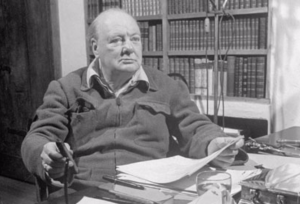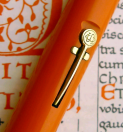
Sir Winston Churchill, at his desk, holding a cigar, with pen by his side. Recent access to letters that he wrote, mentions his use of CS “Self Filling Stylo,” Miles Martin, Onoto and Swan “Red Dwarf Stylographs.”
The Conway Stewart Churchill, unlike Sir Winston himself, suffered from problems they say that were brought about by design flaws. Sir Winston lived up to the age of 90, his physical self was abused by war, accidents, and personal health neglect. Obviously overweight, he loved his Scotch and his large Maduro Romeo y Julieta cigars yet still made it to age 90. Unfortunately the CS Churchill a fountain pen named in honor of the man, suffers from reliability issues even if the pen lives a well cared for life. So frustrating it is for some owners, that they choose to sell it or bury it in a drawer after a few failed attempts of filling or once it springs a leak.

Duro No.1T on the left beside a Churchill. Photo from ebay mhys10cd
The pen was released in 1996, during the watch of Don Yendle. The pen was to celebrate the life of Sir Winston Churchill. It was based on the 1920’s CS Duro No.1. The Duro No.1 was one of the largest pens of it’s time. It was bigger than a Duofold, bigger than a modern 149. It had a huge nib measured to be between a 8-10 nib depending on your measurement system. The similarities of the Duro No.1 and the Churchill are in its general shape, length and clip. The Duro No.1 however, has a beefier flanged lever with the CS shield at the lollipop end and the bigger nib. One of the rants of the modern Churchill is the rickety flimsy looking lever, with owners complaining of looseness and that the nib is smaller than that of a modern 149 and M1000.
It was suppose to compete against flagship models such as the Montblanc 149 and the Pelikan M1000. I cannot find any mention of who was the actual designer of the pen but who ever designed it came out with what would become such a recognisable pen. The pen has been described as “Edwardian” in design, an era that chose to dial down the extravagance of the “Victorian” era. A clear example of this would be the Montblanc Charles Dickens Writers Edition that has been described as having a “Victorian” design as compared to the Churchill having an “Edwardian” design. When set beside each other, these characterisations becomes evident.

Beefier flanged lever on the Duro No.1. Photo from ebay mhys10cd
Unfortunately the Churchill had issues, issues declared, explained and solved by it’s owners but muddled by corporate cover ups, denials and Churchill sheep. The problems were never acknowledged by CS but solved by them under the condition that no one opened the pen and had a look see before it was sent back to them for repair. Not all Churchills have issues, the most common problem is a lever filler problem. The net mentions that an earlier batch of Churchill sacs, during the Yendle watch had issues. The design of the Churchill intended to use a sac and J-Bar, readily available in the parts bin and with suppliers (component/platform manufacturing sharing.) There was probably no dedicated designed sac or J-Bar. The design used an available small sac that fit the small opening at the section but could use a way much bigger sac in the large barrel. The available J-Bar had to be bent downward for it to compress the small sac. When the lever was cycled, it would push the J-Bar down, the end of the J-Bar would have a downward cutting motion into the sac where it is attached to the section. This motion would eventually tear the sac.
Richard Binder would mention in FPN that another problem was a defective sac. There are a lot of illustrations online on the design flaw. Eventually pen men would find out the problem and its fix. I chose to send 2 Churchills to Mike and Linda Kennedy of Indy Pen Dance. Binder was one of the first to find out what the problem was and came up with a fix. Mike and Linda Kennedy are proteges of Binder and he personally endorses and vouches for the Kennedys. I was also in touch with Danny Fudge who is familiar with the problem and knows the fix, he has fixed Churchills. The website of Ron Zorn has a testimonial of a very satisfied customer who had 2 CS Churchills repaired.
http://www.fountainpennetwork.com/forum/topic/127119-cs-churchill-lever-filler-repair-help/
The basic problem was that the lever location could not press on the J-Bar enough to compress the sac. The bandaid solution that CS did to get max J-Bar movement resulted into the J-Bar cutting into the sac. Symptom would be leakage at the lever. Since Binder had retired from repairing pens, I went to his students. The fix can be a DIY but not for the ordinary Joe as described by Binder in his above post. An additional task for the DIYer is that the poorly designed J-Bar is glued at the bottom of the barrel and needs to be drill tapped just enough to release the J-Bar. Probably glued because the available J-Bar probably rattled/moved around in the large Churchill barrel. The service provided by Indy Pen Dance is called the “Binder Sac and Pressure Bar Fix.” I presume this would include the appropriate size sac that would fill the most with the least pressure, that would be durable and agree with Dubiel principles. Further, the use of the appropriate J-Bar, that would compress the sac the most with the least amount of pressure needed from the lever and most of all do no harm to the sac.
In 2002, CS would introduce the c/c Churchill while somewhere between 1996 and 2002 a button filler was introduced. When Glenn Jones became Managing Director, in 2003, replacing the resigned Don Yendle, the Churchill sac tearing problem got solved but they used the same J-Bar which continued to give poor filling problems in the form of miniscule filling. Additional problems included flow reliability, from drying up to blobbing problems. These problems where diagnosed to have feed issues and sac to section issues. A pen with flow problems was lucky enough to be sent to Binder with cost being foot by CS.
So let’s sum things up-
- There are lever fill, button fill and c/c Churchills.
- It seems early Churchill’s are the ones with problems, but there are some later ones with problems.
- The lever fill problem is leakage from the sac, brought about by a poorly designed lever fill system. If the sac hasn’t been torn yet by the J-Bar, the symptom would be poor filling.
- The c/c isn’t trouble free. The most common problem of c/c’s are flow problems and converter problems.
- Button fillers also have problems with the most common being difficult and inadequate filling.
- The good thing about all of this is that they are all repairable.
- Most of all, not all Churchills have problems! Except that you wont know if what you have has issues.
I own 2 woodgrains (I really don’t know if it is a red ripple or a woodgrain), #042/500 with an Italic Medium Nib and #176/500 with a Medium Nib. 42 was an auction win, was left in a pen cup for years, I got it at a very good price. When I took receipt of the pen. It was in some minor neglected form. I masked the furniture and engravings and it was polished back to its former glory. I flushed the sac by eyedropper with water. After 3 months, it leaked at the lever. So it flew back to the US c/o of my friend Prof. Butch Dalisay of penmanila, it was mailed in Chicago and made its way to Indy Pen Dance in Indiana. 176 was another auction win, a drawer find and non runner , that I also got for a steal. This time I asked that it be delivered to Indy Pen Dance and join the work queue with 42. I asked for both to undergo the “Binder Sac and Pressure Bar Fix” and the “Binder Nib Smoothening and Tuning.” I also asked a restoration work on 176, if needed, as it was a drawer find that I haven’t seen yet. Exactly 6 months later, as promised, the pens were done. They both underwent the “Binder Sac and Pressure Bar Fix” and the “Binder Nib Smoothening and Tuning,” 176 didn’t need a restoration as the routine service polishing was good enough to bring it back to it’s glory. Binder claims his Churchill fix will “Increase capacity and enhance reliability” (some who have had the Binder fix questions the increase in capacity claim) which is what I’m hoping for. I’m also hoping that the Binder nib work will address Churchill flow issues. The pens are still in So Cal, being packed and consolidated by my brother with other pens (a Montblanc 149 Desk Set!) and then shipped to San Diego. You guessed it, Prof. Butch Dalisays daughters home. My pens should make it back to Manila by the end of the month with Prof. Butch. Really can’t wait!
So, should you buy a Churchill? Of course! I believe any collector worth his salt, if he has to have only one modern CS, it should be a Churchill, unless of course you buy some Limited Edition like a Michael Jecks. If you are a large fountain pen collector, then it is a must have. Is it worth the pains? Yes it is! There are a lot of Churchill owners who use it as an edc and an only pen. I’m constantly on the hunt for a Churchill.
The Churchill is like a box of chocolates, you’ll never know what you’ll get, but whatever it is, even with it’s quirks, it’s one hell of a chocolate…after you sort out the nuts.
Write away!
You must be logged in to post a comment.